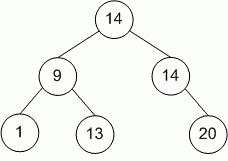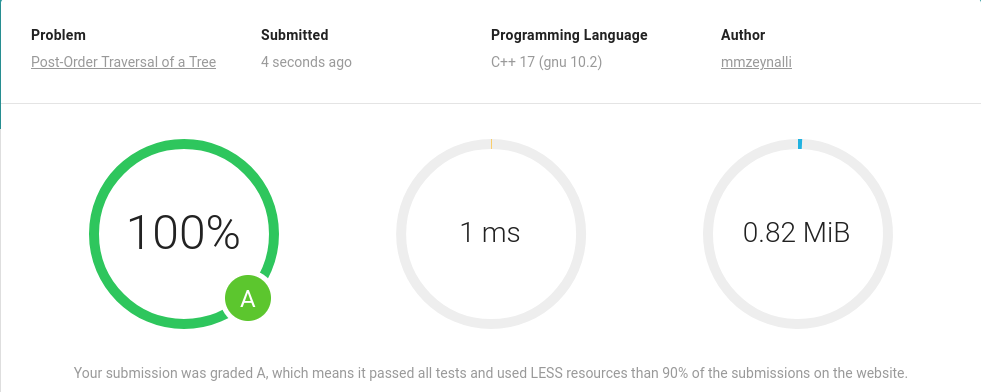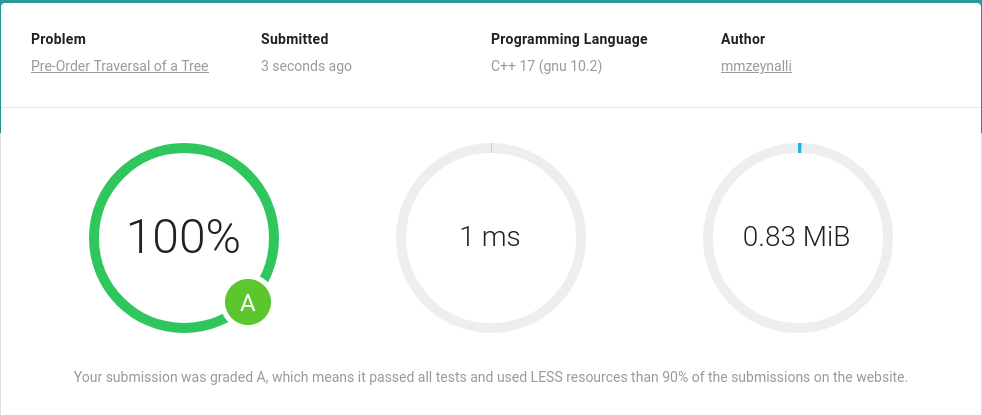Solving DSA Problems. Eolymp 4036 & 4038: Pre-Order/Post-Order Traversal of a Tree
 Miradil Zeynalli
Miradil ZeynalliTable of contents

Problem statement
These are two identical problems: Eolymp 4036 and 4038.
The following problem statement is that of 4038, but explanation covers both problems.
Given an array of integers. Create a Binary Search Tree from these numbers. If the inserted value equals to the current node, insert it to the right subtree.
Write method PostOrder that makes Post-Order traversal of a tree. In this traversal method the left subtree is visited first, then the right subtree and finally the root node.

Write the code according to the next interface:
class TreeNode
{
public:
int val;
TreeNode *left;
TreeNode *right;
TreeNode(int x) : val(x), left(NULL), right(NULL) {}
};
class Tree
{
public:
TreeNode *head;
Tree() : head(NULL) {};
void Insert(int val); // Insert number val to Binary Search Tree
void PostOrder(void); // Print the vertices of a tree according to post-order traversal
};
You can create (use) additional methods if needed.
Input data
The first line contains number n (1 ≤ n ≤ 100). The second line contains n integers.
Output data
Create the Binary Search Tree from input data. Print the vertices of a tree according to post-order traversal.
Examples
Input example #1
6 14 9 1 14 20 13
Output example #1
14 9 1 13 14 20
Solution
First, we need to understand binary search tree. It is a tree, where each node has at most two children (thus binary). For each subtree, the left contains values less than subtree root value, and the right contains the values more than that. Considering that the first value is always the root of the whole tree, we can derive the next insertion steps: if the new value is less than root node, we go to left, otherwise to right subtree. we iterate through each subtree (again, if less go left, if more go right) until we find a empty node. When empty node is found we add the value there. This makes our binary search tree sorted always, which is one of the benefits of this data structure (check problem statement image). So, our insert function would look like this:
void insert(Node *&node, int n)
{
if (node == NULL) // found empty place
{
node = new Node(n);
return;
}
if (n < node->val) // if less, go left
insert(node->left, n);
else
insert(node->right, n); // if same or more, go right
}
That's it! Our binary tree is done! The next step is to add traversal functions. So, if we want to print sorted output, we would always print the left subtree (lower values), then current node, then right subtree (higher values). However, we are asked preorder (4036) and postorder (4038) output. Then, we just change the order of printing:
void PreOrder(Node *node)
{
if (node == NULL)
return;
printf("%d ", node->val);
PreOrder(node->left);
PreOrder(node->right);
}
void PostOrder(Node *node)
{
if (node == NULL)
return;
PostOrder(node->left);
PostOrder(node->right);
printf("%d ", node->val);
}
So, the whole code looks like this:
#include <bits/stdc++.h>
using namespace std;
class Node
{
public:
int val;
Node *left, *right;
Node(int n)
{
val = n;
left = right = NULL;
}
};
class Tree
{
public:
Node *head;
Tree()
{
head = NULL;
}
void insert(int n)
{
insert(head, n);
}
void insert(Node *&node, int n)
{
if (node == NULL)
{
node = new Node(n);
return;
}
if (n < node->val)
insert(node->left, n);
else
insert(node->right, n);
}
};
void PreOrder(Node *node)
{
if (node == NULL)
return;
printf("%d ", node->val);
PreOrder(node->left);
PreOrder(node->right);
}
void PostOrder(Node *node)
{
if (node == NULL)
return;
PostOrder(node->left);
PostOrder(node->right);
printf("%d ", node->val);
}
int main()
{
int n, a;
Tree t;
scanf("%d", &n);
while (n--)
{
scanf("%d", &a);
t.insert(a);
}
// PreOrder(t.head);
PostOrder(t.head);
printf("\n");
return 0;
}
So, if we test our code:

The first one is postorder, and the second is preorder. It works! Now, if we submit:


Two A's! Yay! You can access the code here. Feel free to contribute your solution in different language!
Subscribe to my newsletter
Read articles from Miradil Zeynalli directly inside your inbox. Subscribe to the newsletter, and don't miss out.
Written by

Miradil Zeynalli
Miradil Zeynalli
💬 Who am I? I am Miradil Zeynalli, a graduate of ADA University, one of the leading universities in Baku, Azerbaijan. Currently studying Embedded Electronics Engineering in Lund University, Sweden. Have Embedded Software Engineer experience of 3.5 years, and one year experience as Lead Django Developer. 🔭 What else do I do? Besides embedded engineering, I am also interested in Data Science and Machine Learning. In the last year of bachelor's, I did my Senior Design Project in "Statistical Analysis and Visualization of BP DTS data", where we worked with data from oil wells of British Petroleum. Furthermore, I developed a timetable program that uses AI for assigning time slots to courses. 🤔 How do I use my time? During my leisure time, I prefer to read (I love Dan Brown’s books), watch movies, and sometimes read articles about quantum computing. As a former professional chess player (and the world champion), I actively play chess on online platforms. Feel free to challenge me! In fact, right here, right now! See below :) ⚡ Fun facts Favorite movie: The Dark Knight, Twelve Angry Men Favorite actor: Morgan Freeman Favorite author: Dan Brown Favorite book: The Da Vinci Code Favorite sports: Chess, Basketball